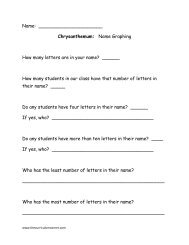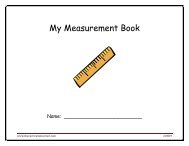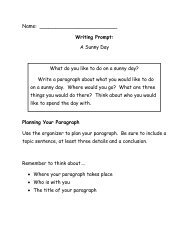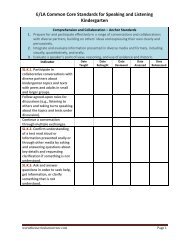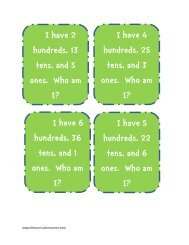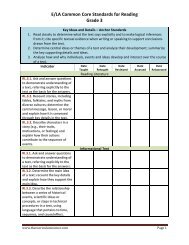Lindsay Sherman Lesson Plan Earth Science - The Curriculum Corner
Lindsay Sherman Lesson Plan Earth Science - The Curriculum Corner
Lindsay Sherman Lesson Plan Earth Science - The Curriculum Corner
You also want an ePaper? Increase the reach of your titles
YUMPU automatically turns print PDFs into web optimized ePapers that Google loves.
<strong>Lindsay</strong> <strong>Sherman</strong> <strong>Lesson</strong> <strong>Plan</strong> <strong>Earth</strong> <strong>Science</strong>Subject: <strong>Science</strong>Cross Curricular IntegrationSocial Studies: <strong>The</strong> students willexplore and research the history offossils.Language Arts: Students will writeand explain what they learned aboutsedimentary rocks.Art: Students will make their ownfossils using clay.Reading: Teacher will read Rocks inHis Head and Let’s Go Rock Collectingto the class.Pre-assessmentAs a class complete a KWL chart onthe Smart Board or dry erase board.<strong>The</strong> class will determine what theyalready know about rocks/soil, whatthey want to know, and what theyhave learned at the end of the lesson.This will help determine what theclass knows already and will alsoprovide a focus for instruction.Materials/EquipmentLayered cakeSample sedimentary rockSedimentary Stacker Materials:Clear plastic bottleFunnelWaterSandGravelChalk powderStudent Created Fossil Materials:Fossil representations: paper clips,pennies, dice, etcPlay-doh (for student created fossils)Topic<strong>Earth</strong>’s ResourcesContent Statement<strong>Earth</strong>’s nonliving resources havespecific propertiesEssential Question/Big IdeaWhat are some properties of the<strong>Earth</strong>’s sedimentary rocks?Learning Objective: Afterparticipating in classroomdiscussions and experiments,students will be able to identifyspecific properties of the <strong>Earth</strong>’snonliving resources (asmeasured by the KWL Chart,teacher checklists, and studentwork samples).Formative AssessmentHave the students fill out avocabulary map with the words“sedimentary rock”.Questions to Ask during <strong>Lesson</strong>:What does this desertresemble?What do you think will happenwhen we shake the bottle?Why do think the differentlayers formed?What makes up the differentlayers?Why do you think this is called asedimentary rock?Do you know of any other typesof rocks?Grade: 2 nd or 3 rdLiterature-Rocks In His Head by CarolOtis Hurst-Let’s Go Rock Collecting byRoma GansSummative AssessmentStudents’ drawings andobservations.Possible Assignments(homework or in class):-Drawing and labeling ofpicture-2-4 sentences writtenabout what students havelearned about sedimentaryrocks
EngageBefore the lesson prepare a layeredcake – one layer of chocolate cake,one layer of white cake and one layerof strawberry, divided by layers ofchocolate and vanilla icing. Askstudents what they notice about it.Does it resemble anything they seeon <strong>Earth</strong>? Tell the class that itactually resembles rock layers. Showan example of a real sedimentaryrock. Ask the students to compareand contrast it to the desert. Tell thestudents they are going to createtheir own “Sedimentary Stacker”using real materials they would findoutside.DifferentiationVisual-Spatial Learners- Allow thesestudents to express their knowledgethrough drawings and paintings.Intrapersonal- Allow these studentsto record their observations andfindings in a journal.Naturalistic- Allow these students toexplore and observe rock samplescollected from the outdoors.Interpersonal- Allow these studentsto collaborate and work with others.Explore/Explain/ElaborateExplore:1. As a class, complete a KWLChart.2. Make a class “SedimentaryStacker” using the clear plasticbottle, the funnel and thesuggested stacking materials.Have individual students comeup and funnel the differentforms of rock layers into thebottle. Add water, shake andobserve the different layersformed.Explain:1. Ask the students to identifythe different layers in the bottleand what they look like.2. Explain that this is an exampleof sedimentary rock and explainwhy (properties).Elaborate:1. Explain to the students thatfossils are typically found insedimentary rocks. <strong>The</strong> deadorganisms become sediments,which then forms into asedimentary rock.2. Have students make theirown fossils using Play-doh andfossil representations.Possible InterventionsMagazines in the classroom forstudents to look through forpictures to cut out instead ofdrawing their own.Create worksheets with a wordbank for the students who needintervention.Evaluate/Conclusion1. Conclude by reading thebook Rocks in His Head.2. Students will draw andlabel a picture of what their“Sedimentary Stacker”looked like.3. Students will also write2-4 sentences about whatthey learned.4. As a class, complete the“L” column on our KWLchart to determine whatthe students learned.EnrichmentProvide a rock collection inthe room for students tolook through and classifydifferent properties ofrocks (color, shape, size,texture, etc.)



